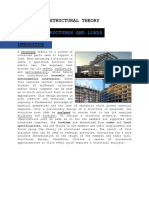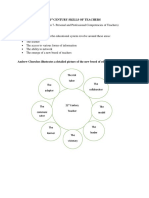0 ratings0% found this document useful (0 votes)
109 viewsStructure Is A Fundamental, Tangible or Intangible Notion Referring To
Structure refers to the organization and relationships between entities. It can describe both tangible objects like buildings as well as intangible concepts like social systems. Structure provides strength, stiffness, and support. There are many types of structures including physical, biological, chemical, musical, social, and data structures. Architectural structures specifically are free-standing outdoor constructions that can be either temporary or permanent, and include both buildings meant for occupation and non-building structures like bridges and monuments.
Uploaded by
Richard SuCopyright
© © All Rights Reserved
Available Formats
Download as DOCX, PDF, TXT or read online on Scribd
0 ratings0% found this document useful (0 votes)
109 viewsStructure Is A Fundamental, Tangible or Intangible Notion Referring To
Structure refers to the organization and relationships between entities. It can describe both tangible objects like buildings as well as intangible concepts like social systems. Structure provides strength, stiffness, and support. There are many types of structures including physical, biological, chemical, musical, social, and data structures. Architectural structures specifically are free-standing outdoor constructions that can be either temporary or permanent, and include both buildings meant for occupation and non-building structures like bridges and monuments.
Uploaded by
Richard SuCopyright
© © All Rights Reserved
Available Formats
Download as DOCX, PDF, TXT or read online on Scribd
You are on page 1/ 3
Structure is a fundamental, tangible or intangible notion referring to
the recognition, observation, nature,
and permanence of patterns and relationships of entities. This notion may itself
be an object, such as a built structure, or an attribute, such as the structure of
society. From a child's verbal description of a snowflake, to the detailed scientific
analysis of the properties of magnetic fields, the concept of structure is now
often an essential foundation of nearly every mode of inquiry and discovery
in science, philosophy, and art.
[1]
In early 20th-century and earlier
thought, form often plays a role comparable to that of structure in contemporary
thought. The neo-Kantianism of Ernst Cassirer (cf. his Philosophy of Symbolic
Forms, completed in 1929 and published in English translation in the 1950s) is
sometimes regarded as a precursor of the later shift
to structuralism andpoststructuralism.
[2]
The description of structure implicitly offers an account of what a system is
made of: a configuration of items, a collection of inter-related components or
services. A structure may be a hierarchy (a cascade of one-to-many
relationships), a network featuring many-to-many links, or a lattice featuring
connections between components that are neighbors in space.
Read more: http://www.answers.com/topic/structure#ixzz2LjzIGB7U
An arrangement of designed components that provides strength and stiffness to
a built artifact such as a building, bridge, dam, automobile, airplane, or missile.
The artifact itself is often referred to as a structure, even though its primary
function is not to support but, for example, to house people, contain water, or
transport goods. The primary requirements for structures are safety, strength,
economy, stiffness, durability, robustness, esthetics, and ductility. The safety of
the structure is paramount, and it is achieved by adhering to rules of design
contained in standards and codes, as well as in exercising strict quality control
over all phases of planning, design, and construction. The structure is designed
to be strong enough to support loads due to its own weight, to human activity,
and to the environment (such as wind, snow, earthquakes, ice, or floods). The
ability to support loads during its intended lifetime ensures that the rate of
failure is insignificant for practical purposes. The design should provide an
economical structure within the constraints of all other requirements. The
structure is designed to be stiff so that under everyday conditions of loading and
usage it will not deflect or vibrate to an extent that is annoying to the occupants
or detrimental to its function. The materials and details of construction have
durability, such that the structure will not corrode, deteriorate, or break under
the effects of weathering and normal usage during its lifetime. A structure
should be robust enough to withstand intentional or unintentional misuse (for
example, fire, gas explosion, or collision with a vehicle) without totally
collapsing. A structural design takes into consideration the community's esthetic
sensibilities. Ductility is necessary to absorb the energy imparted to the
structure from dynamic loads such as earthquakes and blasts. See
also Construction engineering; Engineering design.
Common structural materials are wood, masonry, steel, reinforced concrete,
aluminum, and fiber-reinforced composites. Structures are classified into the
categories of frames, plates, and shells, frequently incorporating combinations of
these. Frames consist of stick members arranged to form the skeleton on
which the remainder of the structure is placed. Plated structures include roof and
floor slabs, vertical shear walls in a multistory building, or girders in a bridge.
Shells are often used as water or gas containers, in roofs of arenas, or in
vehicles that transport gases and liquids. The connections between the various
elements of a structure are made by bolting, welding or riveting.
Read more: http://www.answers.com/topic/structure#ixzz2Lk02kInT
In engineering and architecture, a structure is a body or assemblage of bodies in
space to form a system capable of supporting loads. Physical structures include
man-made and natural arrangements. Buildings, aircraft, soap films, skeletons,
anthills, beaver dams and salt domes are all examples of physical structures.
The effects of loads on physical structures are determined through structural
analysis. Structural engineering refers to engineering of physical structures.
Built structures are a subset of physical structures resulting from construction.
These are divided into buildings and nonbuilding structures, and make up
the infrastructure of a human society. Built structures are composed of structural
elements such as columns, beams and trusses. Built structures are broadly
divided by their varying design approaches and standards,
into categories including Building structures, Architectural structures, Civil
engineering structures and Mechanical structures.
Read more: http://www.answers.com/topic/structure#ixzz2LjzRJGZb
1 Types of structure
1.1 Physical structure
1.2 Biological structure
1.3 Chemical structure
1.4 Musical composition
1.5 Social structure
1.6 Data structure
Read more: http://www.answers.com/topic/structure#ixzz2Lk2SbSvy
An architectural structure is a free-standing, immobile
outdoor constructed element. The structure may be temporary or permanent.
Structures include buildings (occupiedhabitable) and nonbuilding
structures (non-occupiednon-habitable).
1. Examples of building structures include houses, town halls, libraries,
and skyscrapers.
2. Examples of nonbuilding structures include bridges, monuments and
memorials, dams, windmills, and lookout towers.
Structure or building
Often the words architectural structure and buildings are confused, because in
many languages one word covers both. However, a building is a type of
architectural structure used for supporting and sheltering continuous occupancy
or habitation. Building structures (buildings) are therefore usually enclosed
and/or roofed structures. Nonbuilding structures (structures) may be open to the
environment, part of landscape design elements, and/or part
of infrastructure systems (transport, water, energy). Structures also may come
in three forms solid, shell, and, frame. Those may also be combined into a some
buildings.
Temporary structures
Some structures are temporary, built for ephemeral events such as trade
shows, conferences, or theatre, and often dismantled after use. Temporary
structures have fewer constraints relating to future use and durability, and often
comprise lightweight forms such as tents or reusable such as boxcars, which are
quicker to erect, take down, and use at another site or recycle.
Read more: http://www.answers.com/topic/architectural-structure#ixzz2LjzlO1KB
You might also like
- Alchemical Tarot Little White Book - Modo LeitorNo ratings yetAlchemical Tarot Little White Book - Modo Leitor1 page
- Structure: The Whole Is Larger Than The Sum of The Parts100% (1)Structure: The Whole Is Larger Than The Sum of The Parts17 pages
- Building Structures As Architecture, Wolfgang SchuellerNo ratings yetBuilding Structures As Architecture, Wolfgang Schueller8 pages
- SF 1.0 - Structures in Everyday ObjectsNo ratings yetSF 1.0 - Structures in Everyday Objects48 pages
- 1.0.5 Simple Structures and Mechanisms, Electric and Electronic SystemsNo ratings yet1.0.5 Simple Structures and Mechanisms, Electric and Electronic Systems7 pages
- gr.7_technology_worksheets_booklet_memoNo ratings yetgr.7_technology_worksheets_booklet_memo18 pages
- Strong-Structures-Teacher-Recource-PackageNo ratings yetStrong-Structures-Teacher-Recource-Package24 pages
- Space Form and Structure Lecture 02 Loads and ForcesNo ratings yetSpace Form and Structure Lecture 02 Loads and Forces28 pages
- Structural Report For Architectural StudentsNo ratings yetStructural Report For Architectural Students70 pages
- Group 2 Structural and Construction Engineering Management Report Day 1No ratings yetGroup 2 Structural and Construction Engineering Management Report Day 157 pages
- Introduction To Architecture Structure 1No ratings yetIntroduction To Architecture Structure 113 pages
- Surface-Active Structures Such As Shells and Folded Plates, Form-Active Structures Such As Cable orNo ratings yetSurface-Active Structures Such As Shells and Folded Plates, Form-Active Structures Such As Cable or1 page
- Design and Tech - Notes (Syllabus Code - 0445)No ratings yetDesign and Tech - Notes (Syllabus Code - 0445)7 pages
- Roll Number: F16Ce66: Name: Azhar Ali Memon S/O Bilawaluddin MemonNo ratings yetRoll Number: F16Ce66: Name: Azhar Ali Memon S/O Bilawaluddin Memon15 pages
- Building Structures As Architecture, Wolfgang Schueller100% (3)Building Structures As Architecture, Wolfgang Schueller309 pages
- A Periodic Table of Architectural Structures: Conference PaperNo ratings yetA Periodic Table of Architectural Structures: Conference Paper12 pages
- Mateo Fernandez Alonso - Functions of Structures.No ratings yetMateo Fernandez Alonso - Functions of Structures.3 pages
- Structural Analysis: Classification of StructuresNo ratings yetStructural Analysis: Classification of Structures1 page
- Lecture 1 Types of Structures and LoadsNo ratings yetLecture 1 Types of Structures and Loads94 pages
- Referensi: - Bestek Medan Fair - Materi Kuliah MBL - Fundamentals of HVAC Systems - by Robert McdowallNo ratings yetReferensi: - Bestek Medan Fair - Materi Kuliah MBL - Fundamentals of HVAC Systems - by Robert Mcdowall1 page
- Complexity and Contradiction in ArchitectureNo ratings yetComplexity and Contradiction in Architecture1 page
- Essential Bibliography For English Language Teaching and Applied Linguistics PDFNo ratings yetEssential Bibliography For English Language Teaching and Applied Linguistics PDF149 pages
- Philip Bayard Crosby: A Presentation By: Abhishek Kumar and Vishakha Chopra100% (4)Philip Bayard Crosby: A Presentation By: Abhishek Kumar and Vishakha Chopra40 pages
- Peer Observation Instrument To Evaluate The Technical and Pedagogical Features of Hyper StudioNo ratings yetPeer Observation Instrument To Evaluate The Technical and Pedagogical Features of Hyper Studio9 pages
- A Guide To Learning Japanese - Grammar & TestsNo ratings yetA Guide To Learning Japanese - Grammar & Tests37 pages
- George Dickie, Breadsley Phantom Aesthetic ExperienceNo ratings yetGeorge Dickie, Breadsley Phantom Aesthetic Experience9 pages
- Philosophical Assumptions For Qualitative Research 1No ratings yetPhilosophical Assumptions For Qualitative Research 17 pages
- Practice in Artmaking, Art Criticism & Art HistoryNo ratings yetPractice in Artmaking, Art Criticism & Art History8 pages
- Republic of The Philippines Division of Laguna School Year 2016-2017No ratings yetRepublic of The Philippines Division of Laguna School Year 2016-20178 pages
- Harbours and Maritime Networks As Comple PDFNo ratings yetHarbours and Maritime Networks As Comple PDF1 page






























































































